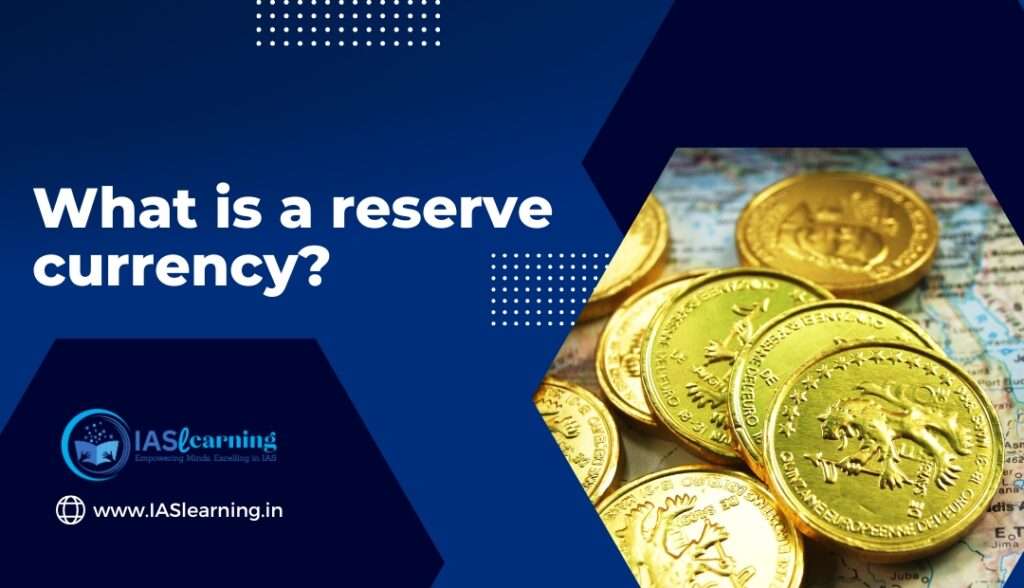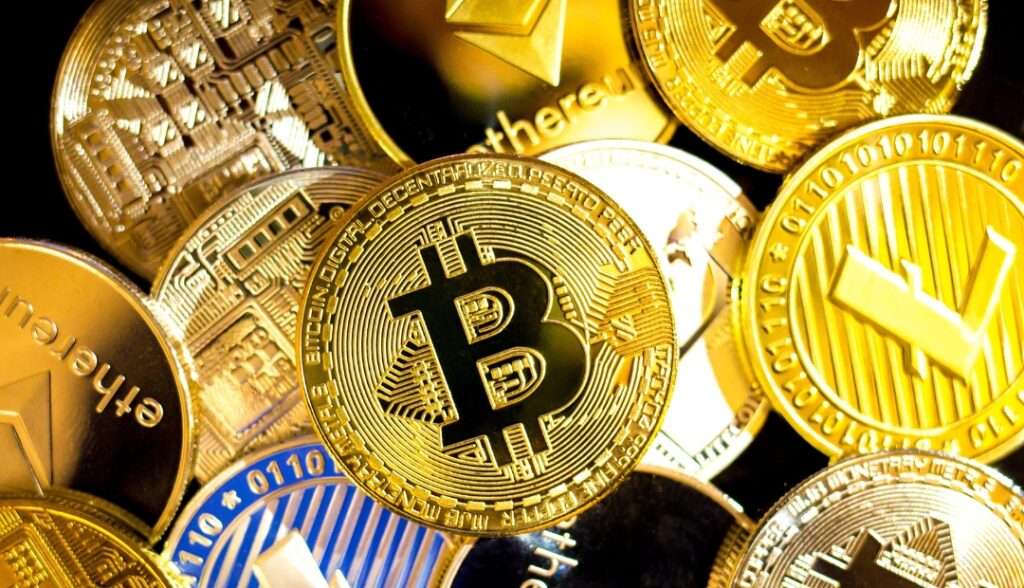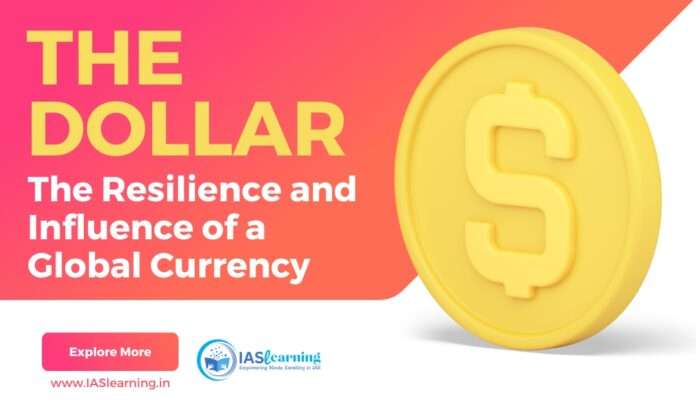Introduction
- The United States dollar (USD) holds a unique and dominant position in the global economy as the world’s reserve currency. This status means that the U.S. dollar is widely accepted and held by central banks, governments, and financial institutions worldwide as a preferred medium for international trade, finance, and investment. The dollar’s status as the world’s reserve currency has profound implications for the global economy, geopolitics, and financial markets
- The dollar has been the primary medium of trade since the end of World War II. It is the most frequently used currency for global trade and other activities, as well as the most generally kept reserve money. The United States has certain advantages from the dollar’s prominence in the world economy, including easier foreign borrowing and a wider range of financial sanctions.
- However, other analysts contend that the high demand for dollars abroad costs the export-heavy states of the United States, leading to trade imbalances and job losses. under the meanwhile, the dollar’s hegemony could be under jeopardy. De-dollarization is a movement whereby many emerging economies want to do commerce using non-dollar currencies. This is especially true in light of the aftermath from the Russian invasion of Ukraine and the COVID-19 outbreak. It seems doubtful that the dollar will be supplanted as the main reserve currency very soon, while few significant challengers have arisen.
What is a reserve currency?

- A central bank or treasury keeps a reserve currency as a component of the official foreign exchange reserves of their nation. In addition to coping with economic shocks, paying for imports, paying off debts, and regulating the value of their own currencies, countries retain reserves for a variety of reasons. Since a large portion of international trade is still conducted in dollars, many countries are unable to borrow money or pay for foreign goods with their own currencies. As a result, they are forced to maintain reserves in order to maintain a steady supply of imports during a crisis and to satisfy their creditors that debt payments denominated in foreign currencies can be made.
- A central bank may affect the value of the currency of its nation by purchasing and selling currencies on the open market, which can promote stability and preserve investor trust. For instance, the Central Bank of Brazil can intervene and utilize its foreign reserves to boost the value of the Brazilian real if it starts to decline during an economic slump. Alternatively, nations might take action to prevent the strengthening of their currencies and reduce the cost of their exports.
- Since they want to be confident they can access their reserves in an emergency, the majority of governments choose to store their reserves in currencies with sizable and open financial markets. Government bonds like US treasuries are a common type of money held by central banks. The U.S. treasury market continues to be by far the largest and most liquid—the simplest to enter and exit—bond market in the whole globe.
- The International Monetary Fund (IMF), the body responsible for monitoring the international monetary system, recognizes eight major reserve currencies: the Australian dollar, the British pound sterling, the Canadian dollar, the Chinese renminbi, the euro, the Japanese yen, the Swiss franc, and the U.S. dollar. The U.S. dollar is the most commonly held, making up 59 percent of global foreign exchange reserves.
How did the dollar become the world’s leading reserve currency?

- The 1944 Bretton Woods Conference, where forty-four nations agreed to the establishment of the IMF and the World Bank, solidified the dollar’s position as the world’s reserve currency. (Some economists contend that by the middle of the 1920s, the dollar had supplanted the British pound [PDF] as the primary reserve currency; others contend that the dollar is the first real reserve currency.) A system of exchange rates was established at Bretton Woods, wherein each nation linked the value of its money to the dollar, which was itself convertible to gold at a rate of $35 per ounce. This was designed to provide stability, and prevent the “beggar-thy-neighbor” currency wars of the 1930s—a response to the Great Depression—by which countries abandoned the gold standard and devalued their currencies to try to gain a competitive advantage.
- However, by the 1960s, the United States did not have enough gold to match the amount of dollars in circulation abroad, which raised concerns that a run may occur and deplete the country’s gold reserves. President Richard Nixon stopped the dollar’s convertibility to gold in August 1971 after unsuccessful attempts to rescue the system, which signaled the beginning of the Bretton Woods exchange rate system’s demise. By weakening the dollar and allowing exchange rates to vary more, the Smithsonian Agreement, which was reached a few months later by 10 major industrialized nations, tried to save the system. However, it was unsuccessful. The present system of largely variable exchange rates was implemented in 1973. Many nations continue to control their exchange rates by either allowing them to fluctuate solely within a specific range or by tying the value of their currency to another, like the dollar.
- The constant value of the dollar, the size of the American economy, and the strength of the US geopolitical position are all factors that contribute to the dollar’s supremacy. Additionally, no other nation has a market for its debt comparable to that of the United States, which is estimated to be worth $22.5 trillion. According to Brad W. Setser of CFR, it is more useful to conceive of US Treasury bonds as the world’s most valuable reserve asset. Without a market comparable to the treasury market, it is difficult to compete with the dollar.
Is de-dollarization happening?

Concerns about the decline of the dollar as the primary reserve currency have returned in light of the economic turmoil brought on by the pandemic and the conflict in Ukraine. Some economists argue that the dollar’s position in the global financial system shouldn’t be taken for granted because there are economic and geopolitical incentives for other countries to de-dollarize. Previous predictions about the dollar’s demise, including those made after the 2008 financial crisis, have not come to pass.
Indeed, some countries are increasingly pushing back against the dollar. At an April 2023 summit of BRICS countries (Brazil, Russia, India, China, and South Africa), Brazilian President Luiz Inácio Lula da Silva asked, “Why can’t we do trade based on our own currencies?”
However, the most commonly suggested alternatives have their own problems:
The BRICS Currency:
- Leaders of the BRICS nations have been debating the structure of a common currency for years, with supporters claiming that it would guard against depreciation as the value of the dollar increases.
- Experts point out that it is impossible due to structural issues in the BRICS nations, such as the absence of strong central banks and sound monetary policies.
Euro:
- The second-most frequently utilized reserve currency is the euro, which makes up around 20% of all foreign exchange reserves in the world.
- With an economy that matches that of the United States, greater exports, a competent central bank, and healthy financial markets, the euro is a serious alternative to the dollar.
- But Setser asserts that its appeal as a reserve currency is constrained by the absence of a single European treasury and a united European bond market.
Renminbi:
- Since the late 2000s, China has worked to increase the renminbi’s influence on the world stage. China has been pushing more and more for the use of the renminbi in bilateral commerce, especially in the aftermath of the Ukraine war, even though it now makes up only 3% of the world’s reserves.
- Chinese leaders, however, have implemented rigorous controls on the flow of money that have stifled the renminbi’s rise because they are mindful of the lessons from earlier currencies that quickly internationalized. According to Zongyuan Zoe Liu of CFR, “China does not have the intention or the ability to dethrone the dollar.”
SDRs are Special Drawing Rights:

- British economist John Maynard Keynes suggested the formation of the “bancor,” a worldwide reserve currency that would be controlled by a central bank, during the Bretton Woods negotiations. While Keynes’s concept was never implemented, there have been suggestions to utilize the Special Drawing Rights (SDR), an internal currency of the IMF that may be converted into hard currency reserves. The euro, the pound sterling, the renminbi, the U.S. dollar, and the yen serve as the foundation for the SDR’s value. The argument put up by supporters is that such a system would be more stable than one based on a national currency, whose issuer is required to address both home and foreign demands.
- However, analysts claim that for the SDR to be extensively used, it would need to behave more like a real currency, accepted in personal transactions with a market for SDR-denominated debt. Additionally, the IMF would need to have the authority to manage the SDR supply, which would be difficult given that the US now holds a de facto veto over the organization’s voting process.
Cryptocurrencies:

- Tech enthusiasts envision a future in which currencies backed by governments are replaced by cryptocurrencies like Bitcoin. Without an issuing body, these digital currencies are “mined” and transmitted over a decentralized network of computers
- Proponents contend that such a system would liberate states from the whims of other countries’ monetary policies. One of their number is El Salvadoran President Nayib Bukele, who has proclaimed Bitcoin legal cash.
- Critics contend that making cryptocurrencies legal money limits a government’s capacity to respond to crises and that their volatility makes them less useful as a medium of trade.
- However, several nations are experimenting with developing digital equivalents of their current traditional currencies utilizing blockchain technology.

